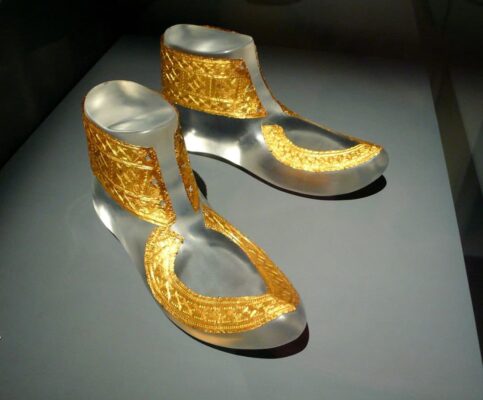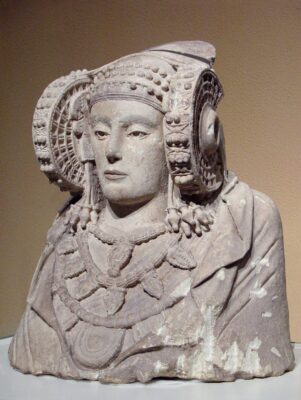Western Europe: Celtic and Iberian Art
The civilised barbarians
“The Celts exceeded all barbarian groups in duration and intensity of contact with the Mediterranean. The southern coasts of Gaul and Spain were Celtic, and for five centuries Greek and Carthaginian traders had been busy along them.”
Derek Williams: “Romans and Barbarians: Four Views from the Empire’s Edge, 1st Century AD”, 1999
Images: Celtic art: Shoe ornament, Hochdorf, c.530 BC. Photograph by Rosemania ·· Iberian art: The “Lady of Elx”, c.500-300 BC. National Archaeological Museum, Madrid. Photograph by Francisco J. Díez Martín.
The scope of the term “Celtic Art” is difficult to specify, as even what we mean by “Celtic people” or “Celtic culture” is partly uncertain. Although generally associated with northwestern Europe, especially Ireland and French Brittany, the Celtic people had their roots in the Hallstatt culture of Central Europe, from where they began a process of expansion, mainly to the north and west. During the Bronze Age, Celtic art produced excellent works of precious metalwork, such as torques and necklaces.
As the Roman Empire took over the territories of the Celtic people, Celtic art incorporated elements of Roman art. In central and northern Europe, after the fall of the Roman Empire and the arrival of Christianity, the artistic style of the Celts, with its characteristic decoration of intricate spirals, trisqueles and other geometric forms, appears in the earliest Christian artworks in the British Isles, in what is known as Hiberno-Saxon Art or Insular Art, as well as in Germanic Art, which will be dealt with in the chapter on the Art of the Migration Period art.
Almost coinciding in time with the Celtic peoples, a series of “high civilisations arose on the Iberian Peninsula which, with different cultural facies (…) nevertheless have many common characteristics: the Tartessian, Turdetan and Iberian cultures” (Lorenzo Abad and Manuel Bendala: “El Arte Ibérico”, 1989). The Tartessian culture, which appeared at the end of the Bronze Age on the southern coast of the peninsula, was a trading civilization, whose contact with other cultures meant that its art incorporated Greek and especially Phoenician elements. After the fall of Tartessos, the Carthaginian-influenced Turdetan culture appeared.
Beyond the area occupied by the Tartessian and Turdetan peoples, the rest of the Iberian Peninsula was inhabited by a series of peoples known collectively as Iberians. The best examples of Iberian Art are limestone sculptures, influenced, as in the case of Tartessos, by the Greeks and Phoenicians. The most famous example is the female bust known as the Lady of Elche (Lady of Elx), created between the 5th and 4th centuries BC, and preserved in the National Archaeological Museum in Madrid, where the Bicha de Balazote (6th century BC), a strange hybrid between a sphinx and a Lamassu is also on display.
The contact between the Celtic and Iberian peoples in the centre and north of the Iberian Peninsula gave rise to the so-called Celtiberian Art, characterised by zoomorphic sculptures with a somewhat crude appearance, of which the most famous example are the Toros de Guisando (Guisando Bulls) in Avila (4th to 3rd centuries BC).
G. Fernandez · theartwolf.com
Follow us on:




